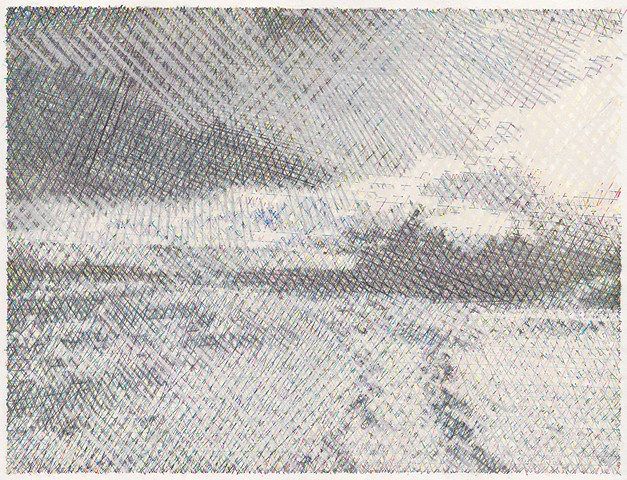ARTIST'S STATEMENTI’m interested in the natural landscape not as a physical place but as a constructed body who’s geography contains layers that preserve both our physical and psychic histories.
My drawings and paintings are densely layered. They draw equally on the color systems of digital pixels and the repeated, mechanical labor of printmaking; but I translate those ways of seeing into obsessively repeated, hand-drawn cross-hatch marks. These marks retain the complexities and contradictions of their source languages, but at the same time the physical process of making them also infuses them with an embodied sense of touch and atmosphere. The resulting landscapes are paradoxical hybrids, simultaneously tactile and “digital” at the same time.
As metaphors, these landscapes reflect the relationship between our bodies and the eternally othered body of the physical world around us. I’m fascinated by our capacity to use technology and labor to sublimate our wants and needs into the idea of a “nature” separate from ourselves. Such a thing doesn’t exist. The landscapes we construct are always combinations of Rorschach tests and psychic projections, less about the physical world and more about our need to construct a parallel world reflecting our own fears, wants, needs, and desires.
These landscapes have a complex mix of sources. Each begins with me documenting a walk, hike, or climb with notes, photographs, and sketches. I will later use these as source material for drawings and paintings based on my fragmentary and incomplete memories of those places. The resulting landscapes are half remembered amalgamations of multiple facts, impressions, and physical spaces. This ambiguity important for me, since it represents an honest recognition of how subjective, fragmentary, and incomplete my own perceptions are and how distant we are from any objective understanding of where the landscape ends and where our own psychic projections begin.
An image that I think about constantly is a hand-made “digital” drawing made by NASA scientists in 1965. That year the Mars Mariner 4 Spacecraft transmitted 22 black and white digital photographs of the surface of Mars back to earth. Transmitting the data for each photograph took over 6 hours, and it took even longer to process the image. The engineers at Nasa didn’t want to wait, so they printed out the numerical color grid of each pixel and colored them in by hand with pastels to slowly construct a picture of “mars”. The value scale and the modular grid structure of the drawing corresponded directly to the transmitted data, but the intensity of the hues was pure invention, reflecting a mars that only existed in the scientists’ imaginations.
I want to make landscapes like that, but of the Earth. I want you to inhabit them and to project yourself onto them, because in the end I suspect my labor is less about documenting a nature outside of us and more about building a mirror reflecting our own complicated nature back at us.
ARTIST'S BIOGRAPHYMichael Zachary grew up in New Hampshire and lives and works in Boston,MA.
He holds a BA from Bowdoin College and an MFA from Massachusetts College of Art and Design.
His most recently solo and two person exhibitions include: Boston University (2025); Simmons University (2025); Cost Annex in Boston, MA (2020); Rhode Island College (2018); Room 68 in Provincetown, MA (2020 and 2017); Frontierspace in Missoula, MT (2016); and The Arts Research Collaborative in Lowell, MA (2014). His work is also featured regularly in group exhibitions nationally and internationally.
In 2024 he was a resident at the Dipper A.I.R program in Billings, MT; in 2020 he received a residency fellowship from the Josef and Anne Albers Foundation and an Assets for Artists Grant from Mass MoCA; in 2018 he was awarded a Finalist’s Grant from the Massachusetts Cultural Council’s Fellowship Program; and in 2017 he received both an individual grant from the Berkshire Taconic Foundation’s Artist’s Resource Trust and a Blanche Coleman Award from Boston University.
He has taught at Northeastern University, The University of Massachusetts at Lowell, and Simmons University and currently teaches painting at Massachusetts College of Art and Design in Boston.
